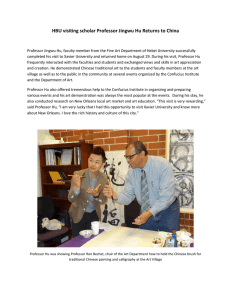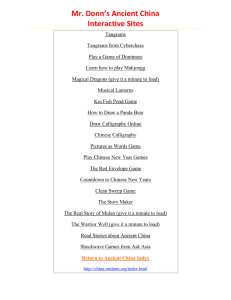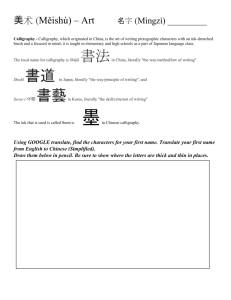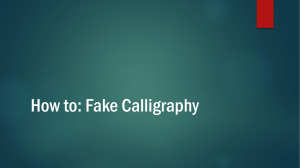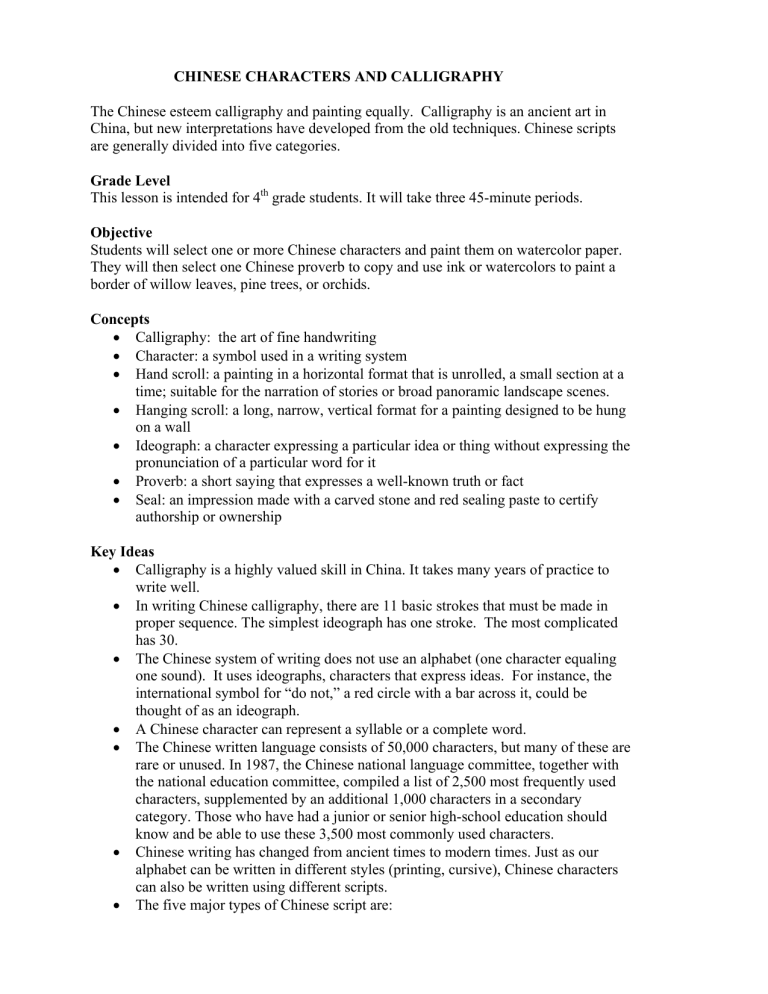
CHINESE CHARACTERS AND CALLIGRAPHY The Chinese esteem calligraphy and painting equally. Calligraphy is an ancient art in China, but new interpretations have developed from the old techniques. Chinese scripts are generally divided into five categories. Grade Level This lesson is intended for 4th grade students. It will take three 45-minute periods. Objective Students will select one or more Chinese characters and paint them on watercolor paper. They will then select one Chinese proverb to copy and use ink or watercolors to paint a border of willow leaves, pine trees, or orchids. Concepts • Calligraphy: the art of fine handwriting • Character: a symbol used in a writing system • Hand scroll: a painting in a horizontal format that is unrolled, a small section at a time; suitable for the narration of stories or broad panoramic landscape scenes. • Hanging scroll: a long, narrow, vertical format for a painting designed to be hung on a wall • Ideograph: a character expressing a particular idea or thing without expressing the pronunciation of a particular word for it • Proverb: a short saying that expresses a well-known truth or fact • Seal: an impression made with a carved stone and red sealing paste to certify authorship or ownership Key Ideas • Calligraphy is a highly valued skill in China. It takes many years of practice to write well. • In writing Chinese calligraphy, there are 11 basic strokes that must be made in proper sequence. The simplest ideograph has one stroke. The most complicated has 30. • The Chinese system of writing does not use an alphabet (one character equaling one sound). It uses ideographs, characters that express ideas. For instance, the international symbol for “do not,” a red circle with a bar across it, could be thought of as an ideograph. • A Chinese character can represent a syllable or a complete word. • The Chinese written language consists of 50,000 characters, but many of these are rare or unused. In 1987, the Chinese national language committee, together with the national education committee, compiled a list of 2,500 most frequently used characters, supplemented by an additional 1,000 characters in a secondary category. Those who have had a junior or senior high-school education should know and be able to use these 3,500 most commonly used characters. • Chinese writing has changed from ancient times to modern times. Just as our alphabet can be written in different styles (printing, cursive), Chinese characters can also be written using different scripts. • The five major types of Chinese script are: a. Seal character script (zhuan), the earliest form of writing (1122-221 BCE); its curly vertical and horizontal strokes tend to be slightly pointed at the end. Reached the peak of development in the Qin dynasty (221-206 BCE). b. Official script (lishu) is a simplified form of the seal script, with straight and angular strokes that could be executed quickly. Its major features are stick-straight vertical and horizontal lines within a tight structure. c. Regular script (kaishu), the standard writing today, is square in form. It developed in the Han dynasty (206 BCE-CE 220), and its bold broad strokes leave more room for the calligrapher to express his/her individuality. d. Grass writing (caoshu), developed in the 700s, features a simplified script with the running together of strokes, rapidly written and with flowing lines; used for making quick but rough copies e. Running script (xingshu) is something between regular and cursive. Extensive practice is necessary to master this technique. Materials Day 1 Listening to the Bamboo, late 1400s-1500s, CMA 1977.172 Old Pine Tree, late 1530s, CMA 1964.43 Bamboo, Rock, and Tall Tree, 1300s, CMA 1978.65 Paintings after Ancient Masters: Scholar with Staff and Brush, 1598-1652, CMA 1979.27.2.19 A Prunus in the Moonlight, 1300s, CMA 1974.26 Poem by Wang Wei, 1256, CMA 1961.421.2 Imperial Gift of an Embroidered Silk: Calligraphy in Running Style, 1525, CMA 1998.169 Album of Landscape Paintings Illustrating Old Poems: A Man Sits at a Table Before an Open Scroll; a Boy Mixes Ink, 1700s, CMA 1982.68.10 Five Pine Trees, 1747, CMA 1976.112 Cloudy Mountains, 1130, CMA 1933.220 Milliken, Linda. China Activity Book, Dana Point, CA: Edupress Inc. 1995. (pp. 8-9, for classroom use only). Williams, Marjorie L. Chinese Painting: An Escape from the 'Dusty' World, Cleveland Museum of Art, 1982. (p. 9 and p.11) Bamboo, Plum, and Other Plants, http://depts.washington.edu/chinaciv/painting/tschyuan .htm Day 2 Brush Rest, Kuan Ware, (1127-1279), CMA 1957.42 Brush Holder, c.1800s, CMA 1945.199 Brush Washer in the Shape of a Lotus Leaf, 1723-1735, CMA 1970.136 Brush with Carved Designs, 1573-1619, CMA 1967.194.a Chynn, Emil William. Chinese Proverbs for Today's World. Kansas City: Andrews McMeel Publishing, 2000. Day 3 ink, paper, pencils, brushes, fabric Procedure: Three-day Lesson Day 1 1. Students will view various works of calligraphy and ink paintings 2. The teacher will read the hand scroll interpretation of: Cloudy Mountains, Five Pine Trees, and A Prunus in the Moonlight. 3. Students will compare and contrast types of calligraphy. Day 2 1. Students will work in cooperative learning groups to brainstorm materials needed for calligraphy and ink painting. 2. Students will view art pieces applicable to the acts of writing calligraphy and painting in ink (e.g., brush, brush rest, brush holder). 3. The teacher will read aloud Chinese Proverbs for Today's World and students will select one to copy. 4. Students will select one or more character(s) to paint. They will practice with paper/pencil. Day 3 1. Students will paint their character. 2. Students will copy their own proverb and illustrate with ink painting. Review paintings first! Evaluation A. Students will define the character they have painted. B. Students will read the proverb they have copied, explain what it means, and describe the illustrations they used to border their proverb. Enrichment A. Students will write their own proverbs and illustrate them. B. Students will work in cooperative-learning groups to design their own hanging scroll (l foot x 6 feet) and paint it on fabric (to imitate silk). Ohio State Standards Language Arts - Writing Application Standard Students need to understand that various types of writing require different language, formatting and special vocabulary. The text form will be a proverb. This lesson was developed by Laurie Mental, 4th grade teacher, Beachwood City Schools, Beachwood, Ohio.
